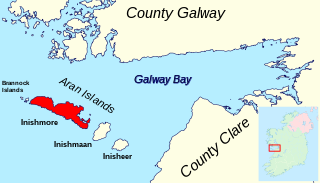
The O'Cahan were a powerful sept of the Northern Uí Néill's Cenél nEógain in medieval Ireland. The name is presently anglicized as O'Kane, Kane and Keane.

Inishmore is the largest of the Aran Islands in Galway Bay, off the west coast of Ireland. With an area of 31 km2 (12 sq mi) and a population of 820, it is the second-largest island off the Irish coast and most populous of the Aran Islands.
Fiachra is an Irish male given name. It may refer to:

Clonfert Cathedral is a cathedral of the Church of Ireland in Clonfert, County Galway in Ireland. Previously the cathedral of the Diocese of Clonfert and then one of three cathedrals in the United Dioceses of Limerick and Killaloe, it is now one of five cathedrals in the Diocese of Tuam, Limerick and Killaloe.
Niall mac Áeda, called Niall Caille to distinguish him from his grandson Niall mac Áeda, was High King of Ireland.
Cumméne Fota or Fada, anglicised Cummian, was an Irish bishop and fer léignid (lector) of Cluain Ferta Brénainn (Clonfert). He was an important theological writer in the early to mid 7th century.
The Bishop of Killaloe is an episcopal title which takes its name after the town of Killaloe in County Clare, Ireland. In the Roman Catholic Church it remains a separate title, but in the Church of Ireland it has been united with other bishoprics.
Events from the year 1114 in Ireland.
Annaghdown is a civil parish in County Galway, Ireland. It lies around Annaghdown Bay, an inlet of Lough Corrib. Villages in the civil parish include Corrandulla and Currandrum. Annaghdown is also an ecclesiastical parish in the Roman Catholic Archdiocese of Tuam and the Church of Ireland Diocese of Tuam, Killala and Achonry.
Ua Corcrain of Clonfert, Abbot of Clonfert, died 1095.
The Abbot of Clonfert was the monastic head of the abbey of Clonfert in County Galway, Ireland. The abbey was founded by Saint Brendan in the early sixth century. The abbots also bore the title "Comarbai Brénaind", "successor of Saint Brendan".
The Abbot of Cork was the head of the monastery at Cork in the province of Munster, Ireland. The monastery was founded by Saint Finbarr in the early seventh century. The abbots also bore the title "Comarbai Báirri", "successor of Saint Finbarr".
Henry Ó Cormacáin, last Abbot of Clonfert, fl.c. 1534-c. 1567.
Muirchertach Ua Carmacáin, Bishop of Clonfert, 1195-1203.
Domnall Ua Finn, Bishop of Clonfert.
Muircheartach mac Pilib Ó Ceallaigh was Archbishop of Tuam in Ireland, and patron of the literary compilation An Leabhar Ua Maine. He was a son of Pilib Ó Ceallaigh, and a brother to William Buidhe Ó Cellaigh, King of Uí Maine and Chief of the Name.
Seaán Ó Connmhaigh was Abbot of Corcomroe and Bishop of Clonfert and Bishop of Kilmacduagh during 1419–1441.
Petrus Ua Mórda was Bishop of Clonfert from circa 1150 to 1171.
Gillagori Ua Dubhacan was Abbot of Aran, Ireland.
Ó Cormacáin is a surname of Gaelic-Irish origin.
This page is based on this
Wikipedia article Text is available under the
CC BY-SA 4.0 license; additional terms may apply.
Images, videos and audio are available under their respective licenses.


